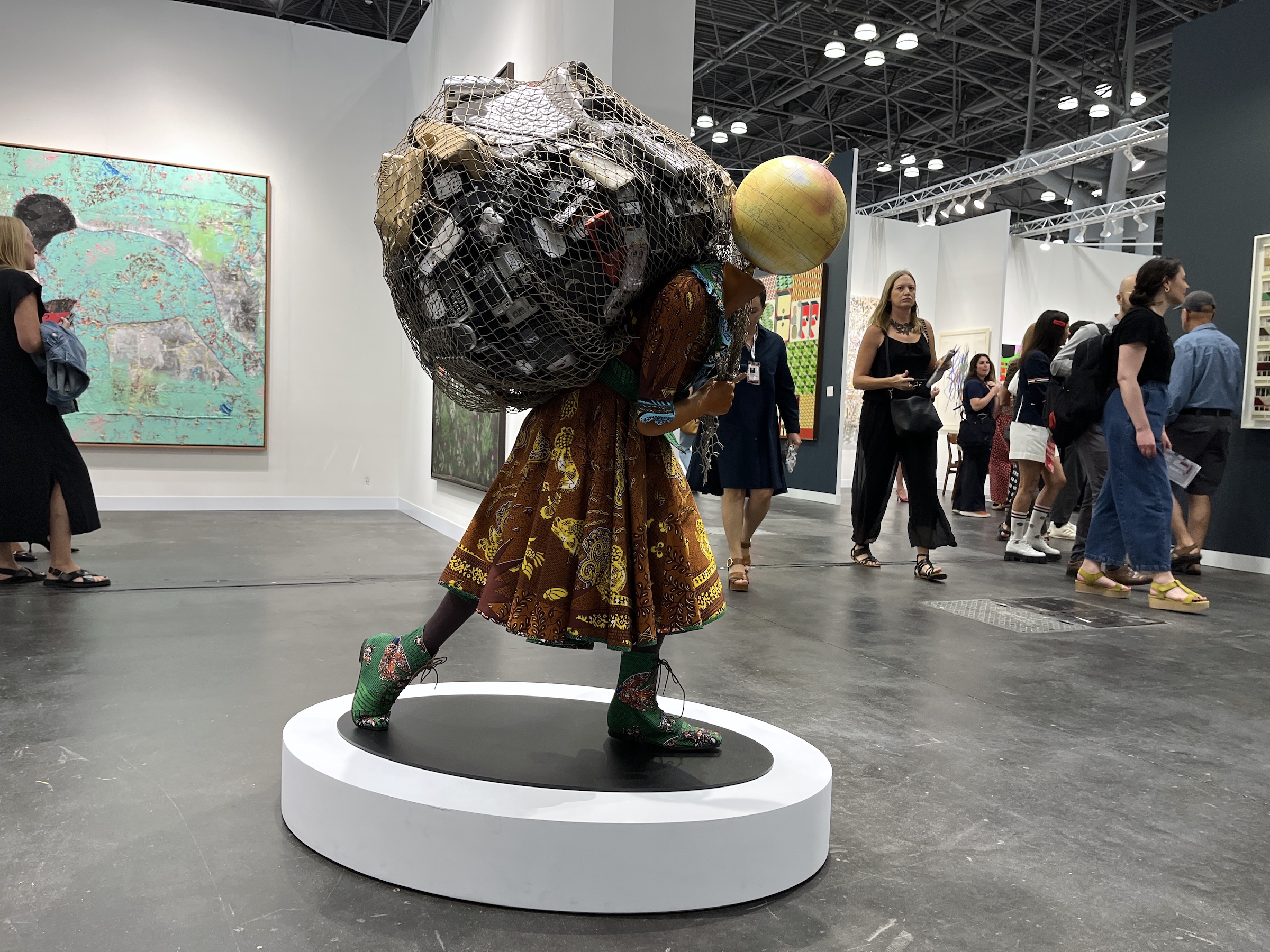
[ad_1]
For much of the day on Thursday, September 5, a wave of pleasant anticipatory energy resembling the first day of school rippled throughout New York City’s largest art fair, the Armory Show.
Well-heeled collectors, art advisors, and other tastefully bejeweled VIPs returning from their summer sojourns streamed into the Javits Center looking for something to fall in love with (or at least appreciate in value better than Bitcoin).
Gallery staff stuffed inside their Midtown convention center cubicles had reasons to be anxious. The top end of the art market has gone through an unexpected downturn as some collectors have been scared off by rising prices. Christie’s auction house reported lower sales compared with 2022 and prices for works by some younger artists plummeted when they went under the hammer this year.
That uncertainty has rattled some attendees, but it hasn’t put a damper on sales among galleries whose buyers haven’t been reselling or putting works up at auction in recent months.
“I think if you as a gallery present yourself as a speculative gallery, then that is what will happen to you,” Stefano Di Paolo, partner and senior director at Tribeca’s Anat Ebgi Gallery, told Hyperallergic. “Our artists are not coming to auction and they’re thinking about institutional placement in the long-term.”

Still, there were plenty of sales to be made.
Kasmin, a blue-chip gallery in Chelsea, sold Robert Motherwell’s 1980–1984 painting “Apse” for $825,000, reportedly a high mark of the day, as well as Walton Ford’s 2023 watercolor “The Singer Tract” for $750,000.
Other contemporary artists with large followings beyond the art world had little trouble unloading their latest works.
Chinese artist and activist Ai Weiwei’s bronze sculpture at Tang Contemporary Art reportedly went for $450,000. An Alex Katz portrait of Ann Lauterbach that was an edition of 40 went for $21,000 at Dusseldorf-based Ludorff gallery’s booth. Meanwhile, Taschen, a luxury art book publisher, had sold or reserved 40 out of 75 copies of a set of 12 skateboards individually hand-painted by Julian Schnabel for $16,000 each. (A Taschen retail manager said that if there were any sets leftover at the end of the fair they would split them up as triptychs for $4,000 apiece).

Most collectors were looking for the next big thing, and this year, the works of women artists making their Armory debut have flown off the walls.
At Miles McEnery, lush colorful paintings by artists Emily Weiner and Gabrielle Garland, both of whom were new to the gallery, were gone on the first day. Weiner’s abstract works went for a range of $7,000 to $14,000 while Garland’s diptych of a modernist interior scene fetched between $30,000 and $35,000. Los Angeles’s Night Gallery sold four brand-new Sarah Miska paintings at a range of $16,000 to $48,000 as well as new works by Claire Tabouret, Sarah Awad, and Elaine Stocki between $10,000 and $30,000. At James Cohan, a pair of watercolor paintings by Naudline Pierre, whose work was also on view elsewhere, sold for about $12,000 each when the fair opened.

Ridgewood-based artist Dana James, who is exhibiting at the Armory for the first time, wasn’t shocked when two of her paintings at Hollis Taggart sold to two different collectors, including a first-time buyer. She attributed the interest in her work to her exploration of the contradictions of beauty present in her painting.
“They both sold, which is amazing,” she said. “I want the work to be beautiful and attractive but also ominous and menacing, and that pulls the right person in.”
Next door at Berry Campbell, a women-owned gallery in Chelsea, co-founder Christine Berry was thrilled to have sold paintings by Nanette Carter ($22,000), Yvonne Thomas ($125,000), and Lynne Drexler ($450,000), which was released from an estate just for the show. She vowed to sell one of Janice Biala’s Abstract Expressionist works before the weekend was over.
“We consistently sell all weekend and we try to bring our best work here,” Berry said. “People know us so they come to our booth for work that is excellent, historic, important, and the next thing to happen.”
Some buyers were intrigued by interesting stories. Tierra Del Sol, a Los Angeles-based gallery that works with artists with developmental disabilities, featured more than a dozen abstract paintings by Michael LeVell, one of its founding artists who is legally blind. LeVell scanned images from Architectural Digest, then drafted them in pencil before going over his drawings in graphite, colored pencil, or marker, while sometimes adding mysterious black circles to his compositions.


At Elizabeth Leach Gallery, Native artist Sara Siestreem learned the craft of basket weaving that her Oregon-based Hanis Coos tribe once practiced, creating several pieces using spruce root, red cedar bark, and sedge. The handwoven baskets can only be sold to institutions for educational purposes and not on the open market, so Siestreem 3D printed copies and made cast ceramic sculptures. All three varieties were exhibited at the fair, as well as several abstract panels of her work.
“Weavers in her tribal community died off and she revived the tradition by creating a self-sustaining tribal program,” said Daniel Peabody, director of Elizabeth Leach Gallery. “Now there are 100 weavers in her tribe whereas there were none 10 years ago.” Now, there’s an aspect of the art market that’s looking a little rosier.
[ad_2]